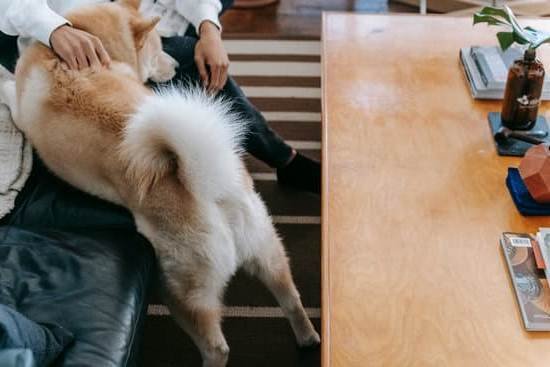Training your dog to hit a bell can be a fun and practical skill that reinforces communication and encourages positive behavior. In this article, we will explore the benefits of teaching your dog this particular trick and provide you with helpful tips on how to successfully train your dog to hit a bell.
When it comes to training your furry friend, incorporating a bell-hitting skill can be a game-changer. Not only does it offer mental stimulation for your dog, but it also serves as an effective communication tool. Whether you want to teach your dog to signal that they need to go outside or simply engage in an interactive activity, hitting a bell can be the perfect way for your pet to express themselves.
In the following sections, we will walk you through the process of introducing and teaching your dog how to hit a bell, covering everything from choosing the right type of bell for your pet to troubleshooting common challenges. With our step-by-step guide and expert tips, you’ll be well on your way to turning this fun trick into second nature for your furry companion.
Choosing the Right Bell for Your Dog
When it comes to training your dog to hit a bell, choosing the right bell is crucial for the success of the training. There are several types of bells available in the market, and it’s important to select one that is suitable for your dog’s size, sound preferences, and training needs.
Exploring Different Types of Bells
There are various types of bells that you can consider for training your dog. Some popular options include classic jingle bells, service bells, or even handheld musical bells. Classic jingle bells provide a distinct sound and are often used for basic bell training.
Service bells are larger and produce a louder sound, which may be more suitable for dogs who have hearing impairments or need a stronger stimulus. Handheld musical bells with different notes can also add an element of fun to the training process.
Tips on Selecting the Right Bell
When choosing a bell for your dog, it’s essential to consider its size and weight. The bell should be lightweight and easy for your dog to manipulate without causing any discomfort. Additionally, pay attention to the sound produced by the bell – some dogs may be more responsive to high-pitched sounds while others may prefer lower tones. It’s advisable to test out different bells and observe your dog’s reaction before making a final decision.
By carefully selecting the right bell for your dog, you can ensure that they are comfortable with the training tool and motivated to engage with it during the learning process. This step sets a strong foundation for successful bell training outcomes.
Introducing Your Dog to the Bell
If you’ve decided to train your dog to hit a bell, the first step is introducing the bell to your furry friend in a positive and exciting way. Here’s a step-by-step guide on how to make the bell an appealing object for your dog:
1. Choose the Right Bell: When introducing the bell, it’s important to select one that is the right size and sound for your dog. Consider whether a small jingle bell or a larger sleigh bell would be more suitable for your pet.
2. Create Positive Associations: Introduce the bell as a fun and exciting toy by associating it with treats or toys that your dog loves. You can also try ringing the bell before mealtime or playtime to create positive associations with the sound.
3. Encourage Exploration: Allow your dog to sniff, touch, and investigate the bell at their own pace. Avoid forcing or intimidating them into interacting with the bell, as this could create negative associations.
By taking these steps, you can help make the introduction of the bell a positive and enjoyable experience for your dog, setting them up for success as you move on to training them to hit the bell on command.
4. Keep Training Sessions Short and Fun: Once your dog has shown interest in the bell, start incorporating short training sessions into your daily routine. Use treats and praise to encourage them to interact with the bell, gradually shaping their behavior until they understand that hitting the bell results in positive reinforcement.
Remember, patience is key when introducing your dog to new experiences like this, so take it slow and celebrate small victories along the way.
Teaching Your Dog to Target the Bell
Introducing your dog to a bell is not only a fun trick, but it can also serve as a useful communication tool. By teaching your dog to hit a bell, you are giving them a way to signal when they need to go outside, when they are hungry, or even when they want to play.
This can be particularly helpful for dogs who may have difficulty vocalizing their needs or for pet owners who want an alternative form of communication with their furry friends.
Step-by-Step Guide
To begin training your dog to target the bell, start by introducing them to the bell in a non-threatening manner. Place the bell on the floor and let your dog investigate it at their own pace.
Once they seem comfortable with the bell’s presence, you can start luring them towards it by placing treats near or on top of the bell. Encourage your dog to interact with the bell by using positive reinforcement such as praise and rewards whenever they show interest in it.
Once your dog is comfortable around the bell, you can start teaching them how to target or touch it with their nose or paw. Hold a treat in your hand and use it to lure your dog towards the bell. As soon as their nose or paw makes contact with the bell, reward them with the treat and praise. Repeat this process several times until your dog consistently touches the bell upon command.
Using Positive Reinforcement
Throughout this training process, it is essential to use positive reinforcement techniques such as treats, praise, and affection whenever your dog successfully interacts with the bell. Positive reinforcement will help create a strong association between hitting the bell and receiving something pleasurable, making your dog more likely to continue performing this behavior in the future.
By following these step-by-step guidelines and utilizing positive reinforcement techniques, you can effectively teach your dog how to target a bell in no time. Remember that every dog learns at their own pace, so be patient and consistent in your training efforts.
Building Consistency and Fluency
Once your dog has mastered the art of hitting the bell, it’s important to focus on building consistency and fluency in this behavior. Consistency is key in ensuring that your dog responds to the bell command every time, while fluency involves making sure that your dog can hit the bell effortlessly and without hesitation.
One strategy for building consistency is to practice the bell-hitting behavior in different locations and under various distractions. For example, you can start by practicing in a quiet room, then gradually introduce more challenging environments such as outside or in the presence of other people or pets. This will help reinforce the behavior regardless of the surroundings.
In addition to practicing in different locations, reinforcing the behavior through positive reinforcement is essential for maintaining consistency. When your dog successfully hits the bell, make sure to reward them with treats or praise to let them know they have done well. This positive reinforcement will help solidify the behavior over time.
To ensure fluency, it’s important to continue practicing the bell-hitting behavior regularly. Incorporating short training sessions into your daily routine will help reinforce this skill. By consistently practicing and rewarding your dog for hitting the bell, you can ensure that they become fluent in responding to this command.
| Benefit | Tips |
|---|---|
| Practicing in different locations | Start with a quiet room then progress to more distracting environments |
| Positive Reinforcement | Reward successful bell-hitting with treats or praise |
| Regular Practice | Incorporate short training sessions into daily routine |
Troubleshooting Common Challenges
The training process of teaching your dog to hit a bell can sometimes present common challenges. One such challenge is when your dog seems uninterested in the bell or hesitant to engage with it. In such cases, it is important to go back a few steps and reintroduce the bell in a different way. This could involve using extra enticing treats or toys to encourage your dog’s curiosity about the bell, making it a positive and rewarding experience.
Another common challenge is when your dog becomes easily distracted during training sessions and fails to focus on hitting the bell. One effective solution for this challenge is to create a designated training area that is free from distractions and noise. It’s important for the training environment to be conducive for learning, so finding a quiet space where you can have your dog’s full attention will greatly improve the success of the training process.
Some dogs may also exhibit behavioral issues during bell training, such as becoming overly excited or overzealous in hitting the bell. In these instances, it’s crucial to practice patience and reinforce calm behavior. Using verbal cues and consistent body language can help in regulating your dog’s excitement levels during training sessions.
| Common Challenge | Solution |
|---|---|
| Uninterested or hesitant behavior towards the bell | Reintroduce the bell in an engaging way with extra rewards |
| Distracted behavior during training sessions | Create a quiet and distraction-free training environment |
| Overexcitement or overzealousness in hitting the bell | Reinforce calm behavior with verbal cues and consistent body language |
Advanced Applications for Bell Training
Once your dog has mastered the skill of hitting a bell, there are several advanced applications that you can explore to further enhance their training and mental stimulation.
Some advanced applications for bell training include:
- Integration into Obedience Training: Once your dog is proficient at hitting the bell, you can incorporate it into obedience training exercises. For example, you can use the bell as a tool to teach your dog to stay in one place until released by hitting the bell. This adds an extra layer of control and communication in obedience training.
- Agility Training: The bell can also be integrated into agility training exercises. You can train your dog to hit the bell at specific points along an agility course, adding an extra element of precision and coordination to their performance.
- Communication Tool: In addition to being a fun trick, teaching your dog to hit a bell can also serve as a useful communication tool. For example, you can train your dog to hit the bell when they need to go outside or when they want attention. This allows them to communicate their needs in a clear and recognizable way.
By exploring these advanced applications for bell training, you can continue to challenge and engage your dog while strengthening your bond through positive reinforcement.
Remember that consistency and patience are key when introducing advanced applications for bell training. With time and practice, your dog will be able to master these more complex tasks and continue to thrive in their training journey.
Maintaining and Reinforcing Bell Training
In conclusion, training your dog to hit a bell can be a valuable and fun activity for both you and your furry friend. Not only does it serve as a great form of mental stimulation and enrichment for your dog, but it also provides a unique way for them to communicate with you.
From alerting you when they need to go outside to simply showing off their new trick, hitting a bell can become a useful skill in your dog’s repertoire.
Once your dog has mastered the art of hitting the bell, it is important to continue reinforcing this behavior to ensure that they maintain their skills over time. By incorporating the bell into your dog’s daily routine, such as making them ring the bell before meals or walks, you can help solidify this behavior. Additionally, using positive reinforcement and continuing to reward your dog for hitting the bell will ensure that they remain enthusiastic about performing this trick.
Remember that patience and consistency are key when it comes to training any new behavior in your dog. If you encounter any challenges along the way, take a step back and reassess your approach. With dedication and persistent practice, you’ll soon find that your dog not only enjoys hitting the bell but also uses this unique skill as a means of communication in various contexts. Happy training.
Frequently Asked Questions
How Do You Teach a Dog to Hit a Bell?
Teaching a dog to hit a bell involves positive reinforcement training. Start by introducing the bell and allowing the dog to investigate it.
Then, encourage the dog to touch or bump the bell with its nose or paw, and immediately reward this behavior with a treat or praise. Repeat this process consistently until the dog associates hitting the bell with getting a reward.
How Do You Train Your Dog to Ring a Bell When It Needs the Toilet?
To train your dog to ring a bell when it needs to go to the toilet, you can follow a similar process as teaching them to hit a bell. Hang the bell near the door that leads outside and encourage your dog to ring it every time before going out.
Once they do so, open the door and allow them to relieve themselves outdoors. Consistency and positive reinforcement are key in this training process.
How Long Does It Take to Bell Train a Dog?
The time it takes to bell train a dog can vary depending on factors such as the individual dog’s personality, age, and previous training experience. For some dogs, it may take only a few days of consistent training for them to learn to hit the bell or ring it when they need to go outside.
For others, it may take several weeks of patient practice before they fully grasp the concept of using the bell for signaling their need to go out. Regardless, being consistent and patient throughout the training process is crucial for success.

Welcome to the blog! I am a professional dog trainer and have been working with dogs for many years. In this blog, I will be discussing various topics related to dog training, including tips, tricks, and advice. I hope you find this information helpful and informative. Thanks for reading!





